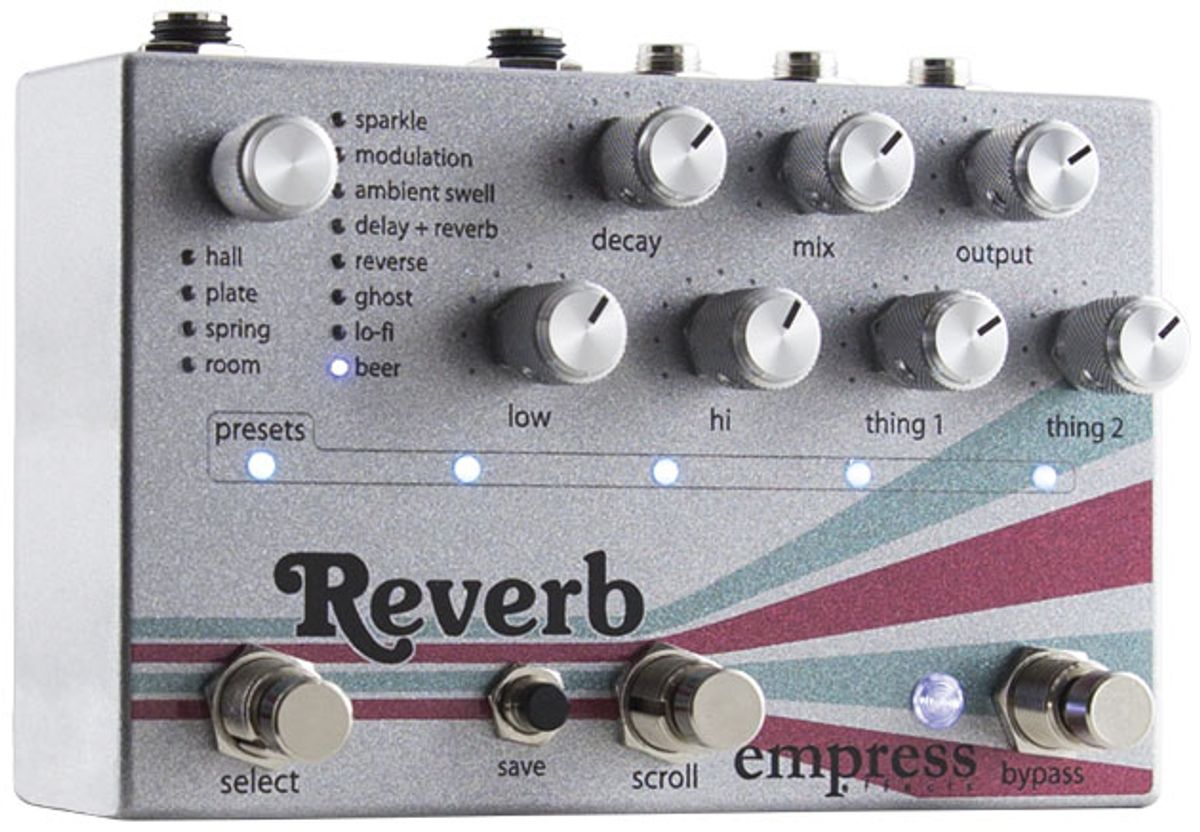
This intuitive deep-space machine rewards tinkerers and traditionalists alike.
Smart Layout, Easy Navigation
The Empress’ cornucopia of features and presets could make heads spin. But the control set is very thoughtfully and sensibly laid out and easy to navigate, which minimizes a potentially formidable learning curve. That said, keeping the manual at your side for first experiments is a very good idea.
The 12 modes on this pedal (Empress is developing more, which can be uploaded via an SD card) represent a cool mix of classic and modern textures and a few of Empress’ own unique creations. The I/O complement includes stereo and mono ins and outs and a multi-function control port that can be used for an expression pedal, external tap tempo control, external audio, or MIDI connectivity. You can also save up to 35 presets. The unit draws 300 mA of current and there’s no battery option.
Sweetly Spacious
The majority of sounds reveal a lot of attention to detail but never feel over-engineered, gimmicky, or excessively complicated. Classic sounds such as spring, plate, hall, and room are authentic and easy to dial in. Some classic settings sounded cleaner than their analog or real-world inspirations. But that’s not all bad when adding ambience to clean tones.
Stranger, more unnatural reverb effects are where the Empress really flexes its muscles. There are shimmer octave-reverbs and modulated reverbs that sound especially fantastic at high modulation rates. Each setting can be further tweaked through variable-function controls that are cheekily labeled “thing 1” and “thing 2.” Classic spring modes, for example, feature three sub-presets. On the “bright spring” setting, thing 1 controls “rattle decay” and thing 2 controls “rattle level”—settings that replicate the mechanical aspects of an actual spring reverb. If we move to the “overdriven spring” sub-preset, thing 1 controls rattle decay and level, while thing 2 controls the amount of break-up. It’s an impressive bit of extra tone tailoring power. Thing settings can get pretty wacky in presets like beer mode, where thing 1 controls the glitch speed (or the rate at which the filter moves between high- and low-pass filters) and thing 2 controls glitch tone (the time the reverb tail spends in either high- or low-pass filter mode).
Ratings
Pros:
Extremely powerful. An absolute bevy of tones including classics and wilder. Intuitive operation.
Cons:
Natural-style reverb can sound a bit too clean. Relatively expensive.
Tones:
Ease of Use:
Build/Design:
Value:
Street:
$449
Empress Reverb
empresseffects.com
Reverse reverb is one of my favorite textures in recorded music—particularly when decays open and flower slowly and peak in volume and resonance just before the primary signal. The Empress’ reverse reverb is subtler than many, lacking some of the dramatic flowering and resonance I prefer, but it’s more likely to work well with stacked effects, and many players will love its gentle contours in slower, more ambient settings.
Empress’ own reverb creations are a ton of fun—particularly the ghost, lo-fi, and beer modes. The ghost mode is very vocal sounding and excellent for dark and spooky ambient textures. Lo-fi, with its subtle-to-swervy pitch modulation, sounds a bit like a broken spring reverb or a really crusty Binson Echorec. Beer mode, meanwhile, is an awesome gated-glitch-filter reverb that can make your guitar sound like an aggressive synth pad.
One peculiarity in the Empress design that’s worth noting is a tendency to boost signal just a bit. My Real Tube overdrive seemed louder than usual when situated in front of the Empress. And while this might be a desirable quality for a lot of players, it could be an issue for folks who use multiple gain pedals simultaneously.
The Verdict
The Empress Reverb is best suited for players willing to devote time to concocting fine textures. There are lots of sounds on tap, and while you can easily get great tones from the classic reverb simulations, Empress rewards the kind of player who enjoys investing a weekend probing every possibility. Players that aren’t interested in such exploration will probably not be able to justify the price. But those that relish digging deeper will likely find the combination of versatility and intuitive navigation worth the investment.


